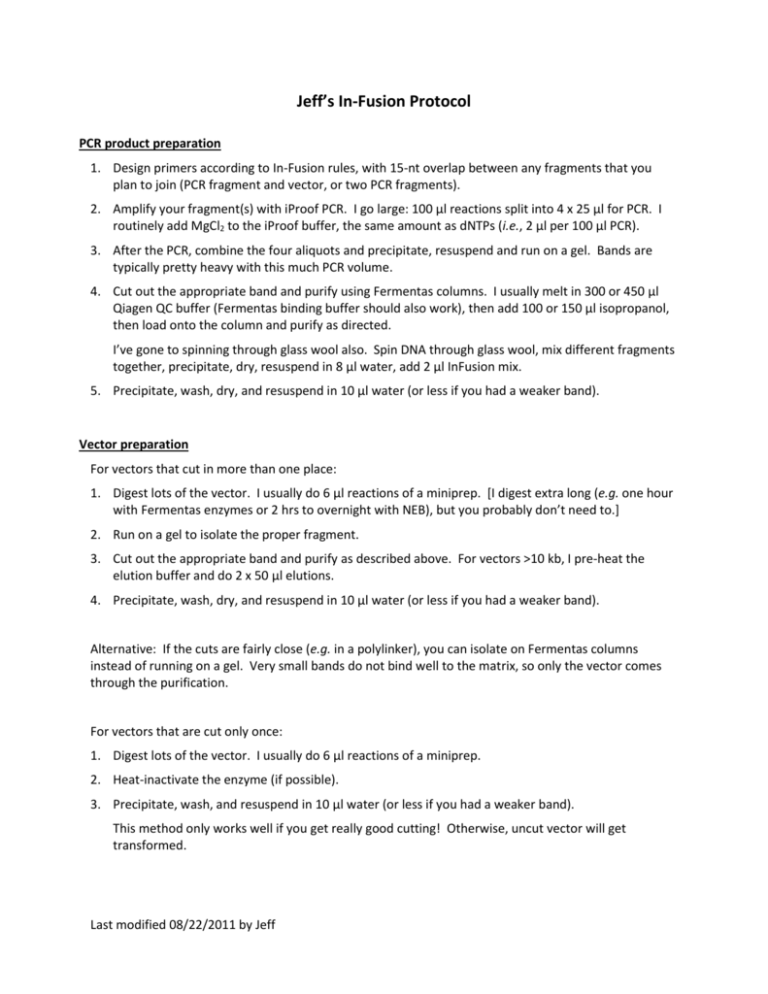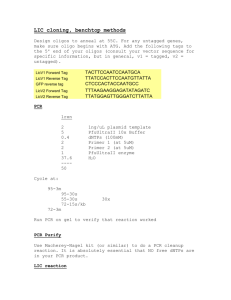Jeff`s In-Fusion protocol
advertisement

Jeff’s In-Fusion Protocol PCR product preparation 1. Design primers according to In-Fusion rules, with 15-nt overlap between any fragments that you plan to join (PCR fragment and vector, or two PCR fragments). 2. Amplify your fragment(s) with iProof PCR. I go large: 100 μl reactions split into 4 x 25 μl for PCR. I routinely add MgCl2 to the iProof buffer, the same amount as dNTPs (i.e., 2 μl per 100 μl PCR). 3. After the PCR, combine the four aliquots and precipitate, resuspend and run on a gel. Bands are typically pretty heavy with this much PCR volume. 4. Cut out the appropriate band and purify using Fermentas columns. I usually melt in 300 or 450 μl Qiagen QC buffer (Fermentas binding buffer should also work), then add 100 or 150 μl isopropanol, then load onto the column and purify as directed. I’ve gone to spinning through glass wool also. Spin DNA through glass wool, mix different fragments together, precipitate, dry, resuspend in 8 μl water, add 2 μl InFusion mix. 5. Precipitate, wash, dry, and resuspend in 10 μl water (or less if you had a weaker band). Vector preparation For vectors that cut in more than one place: 1. Digest lots of the vector. I usually do 6 μl reactions of a miniprep. [I digest extra long (e.g. one hour with Fermentas enzymes or 2 hrs to overnight with NEB), but you probably don’t need to.] 2. Run on a gel to isolate the proper fragment. 3. Cut out the appropriate band and purify as described above. For vectors >10 kb, I pre-heat the elution buffer and do 2 x 50 μl elutions. 4. Precipitate, wash, dry, and resuspend in 10 μl water (or less if you had a weaker band). Alternative: If the cuts are fairly close (e.g. in a polylinker), you can isolate on Fermentas columns instead of running on a gel. Very small bands do not bind well to the matrix, so only the vector comes through the purification. For vectors that are cut only once: 1. Digest lots of the vector. I usually do 6 μl reactions of a miniprep. 2. Heat-inactivate the enzyme (if possible). 3. Precipitate, wash, and resuspend in 10 μl water (or less if you had a weaker band). This method only works well if you get really good cutting! Otherwise, uncut vector will get transformed. Last modified 08/22/2011 by Jeff In-Fusion reaction 1. Mix vector, insert(s), ddH2O, 2 μl 5X buffer, and 1 μl enzyme. Incubate in PCR machine on In-Fusion program. I sometimes check the concentrations by running 2 μl (of 10) on a gel. I don’t end up using as much as the In-Fusion protocol says…probably half that. If the PCR went well and there’s lots of vector, I typically use 3 μl vector and 2 μl each insert. If concentrations are low, I might use all of it - just mix the fragments together, precipitate (or just dry), and resuspend in 7 μl. 2. Transform into competent cells. I now do precipitation or drop dialysis, then go into electrocompetent MACH1 cells. If the vector was single-cut and I didn’t gel purify it, I might digest in 20 μl before removing salt. This will reduce background of vector only, but it only works if your oligos are designed so that the cut site is gone. This will almost always be true for 3’ overhang and blunt enzymes, but often not true for 5’ overhangs. Oligonucleotide insertions 1. Design oligos that are complementary by have 15-nt 5’ overhangs that match the insertion site. 2. Resuspend oligos in TE like usual (50 pmol/μl ). Anneal in the PCR machine. I usually do 3-5 μl each, but that’s way more than you need. 3. For In-Fusion, use 0.5 μl of annealed oligo per 10 μl reaction. Last modified 08/22/2011 by Jeff






